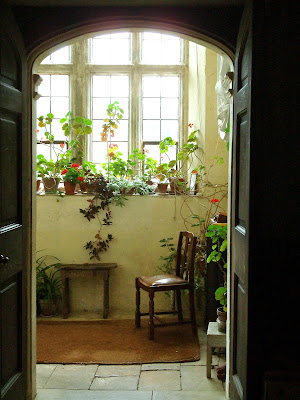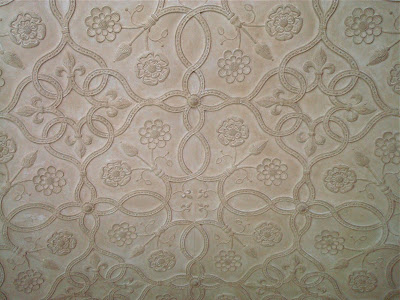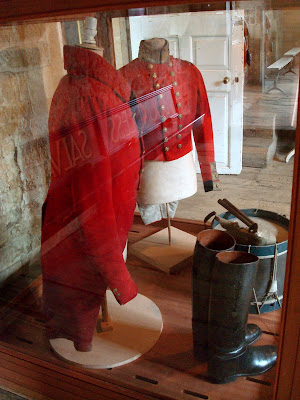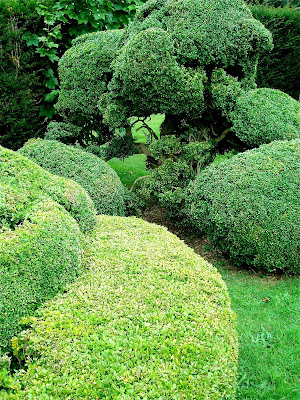I went up to The Cotswolds on Thursday last week so that I could enjoy the area for a day before the vintage fair on Saturday, and decided to visit a house that I had last seen over 20 years ago. Come with me on a little tour of this fascinating place, which has essentially remained unchanged since the early 17th Century.....
Chastleton Manor, near Moreton-in-marsh in Oxfordshire, was built between 1607 and 1612 by prosperous wool merchant Walter Jones; the Cotswolds at the time was a region famous for the quality of its wool.
Today there are still sheep grazing in the field as you pass the honey-coloured dovecote and approach Chastleton through the stone archway......
A rare gem of a Jacobean country house, Chastleton was owned by the same increasingly impoverished family until 1991, when the National Trust took it into its care. For nearly 400 years the interiors and contents gradually succumbed to the ravages of time with virtually no intrusion from the 21st Century.
I spent four memorable summers in the Cotswolds in my late teens/early twenties, exploring the area by way of quiet lanes and footpaths, and it was in 1990 on one of these walks that I first saw Chastleton, and wondered who lived there. The last private owner was in fact a widow called Barbara Clutton-Brock, who lived on in the huge house for 15 years after her husband's death. For the last five years she lived completely alone save for a myriad of cats, until forced to leave due to ill health. Alan Clutton-Brock had inherited Chastleton in 1954, but the expense of maintaining the house was just so immense that only rudimentary renovation was ever done. In fact Barbara boasted that she installed wiring to part of the house herself, providing the first electricity supply. She opened Chastleton to the public on certain days, and you can still see her handwritten signs as you walk around the house. The National Trust has been cautious not to spoil the atmosphere of this remarkable place, and has only carried out essential repair work, most notably the roof. Its strategy has been to preserve Chastleton as it stands, and as a consequence you see the peeling wallcoverings and the wood-wormed windowsills and the dirty ceilings; and cobwebs!
In the entrance porch are these lovely geraniums,
and some of Barbara's homemade signs. (Incidentally, 'yer tis' is the Cornish way of saying 'here it is', and is a reminder of Barbara's roots; her father was a Cornishman.)
In this cosy parlour the wood panelling has unusually been painted a soft grey
The little door in the wood panelling led into a small room lined with shelves of books....(notice the one that has been left upside-down)
A table laden with found objects....garden plant labels and clock numbers
Two glimpses of the garden through an upstairs window
Barbara's bedroom still has an old-fashioned hot water bottle on the eiderdown and fashion magazines from the 70's. Barbara Clutton-Brock described Chastleton as intensely cold and told the National Trust on leaving that she had never felt warm in her life.
This bed has a hand-stitched quilt dating from 1710, with matching pillowcases. It took the lady who made it fifteen years to complete. It was made as part of her daughter's wedding trousseau, but the wedding never happened and so the quilt remained at Chastleton. Such awesomely tiny stitches!
After quite dark and dingy rooms it is an unexpected delight to emerge on the top floor of the house into this long gallery, complete with intricate plaster ceiling and floorboards polished with a thousand footfalls.....
The 'museum room' holds a motley collection of household objects: saddles and tin baths.....
an old hand loom.... these fantastic mannequins!....
some dashing scarlet uniforms.....
and a cabinet containing all the things that have been recovered from beneath the floorboards and behind the walls of Chastleton. This is in a way the most fascinating collection to see, because it is the objects of everyday life that fall through the cracks in the floorboards: coins, playing cards, children's alphabet letters, marbles, scraps of paper and fabric....things that we are familiar with today but of course back then were hand-made of natural materials, no plastic toys here!
A hallway staircase, left as it would have been during Barbara's time in the house.
This lovely arrangement was on a table in the main dining room.
layers of peeling paint and plaster on one of the walls....
The old dresser and cast iron range in the kitchen; no modern conveniences here!
Cobwebs and an old bicycle in the cellar.....
The garden is a lot fuller than when I saw it last; flowers for cutting and lots of fruit and veg.....
The team of volunteer gardeners were just packing up for the day
Bees on the sedum.....
plums and apples ripening in the orchard.....
and a mulberry....
The box topiary shapes in the circular garden have been neglected over the centuries and have assumed random rounded forms. I rather like their waywardness; a reminder that it is only through the neglect forced upon Chastleton by the poverty of its inhabitants that we are able to step back into a place forgotten by time.....
x x x








































































This looks like a beautiful place, I love it when the NT don't 'interfere' too much, its all so much more interesting then.
ReplyDeleteGosh.....what a wonderful post and beautiful photos, almost like being there.....thank you, I so enjoyed it!!!
ReplyDeleteGlorious. O this has been such a treat, I feel as if I just walked through it myself.
ReplyDeleteThe paintings, especially the still life and portrait of the lady with the blue turban are lovely. I wonder if the turbaned lady is Barbara? Know I will come and read this post again. Thank you so much for all the pictures; an engrossing place.
Such a beautiful post. I think I will have to visit now. What a beautiful garden and to think of all those little treasures pushed through gaps of the floorboards by little children's fingers over the years.
ReplyDeleteMelanie x
thank you for sharing that! it is beautiful! i really loved that round garden....sigh
ReplyDeleteWhat a treasure of a place! And so beautifully seen through your eyes...I am so happy its faded charm has been preserved.The long gallery is stunning. Lovely photographs Christine, I am longing to visit next time I head West...in the meantime sending love from 'yer Down the Lane!
ReplyDelete--x--
Serenata Flowers,Serenata Flowers,Serenata Flowers
ReplyDeleteBeautiful images for this grand home.
ReplyDeleteA perfect place to relax.
Angela
What a lovely tour you have given of us a beautiful old house. I am glad the NT have left it in the original state, it is so much easier to imagine living in a house like that.
ReplyDeleteThank you for taking us on this little trip back in time.
ReplyDeleteI Always love it to visit such places...
I visited some castles and gardens in the cotswolds last month; was very nice!
greetings from Fleur-netherlands
Wonderful visit and tour, Thank you!
ReplyDeleteMarcie
My favorite post. Have visited it time and time again. My cousin lives not too far away and I hope to visit some day. Thank you a million times for these images and descriptions. Do you know what happened to all of Barbara's cats?
ReplyDelete